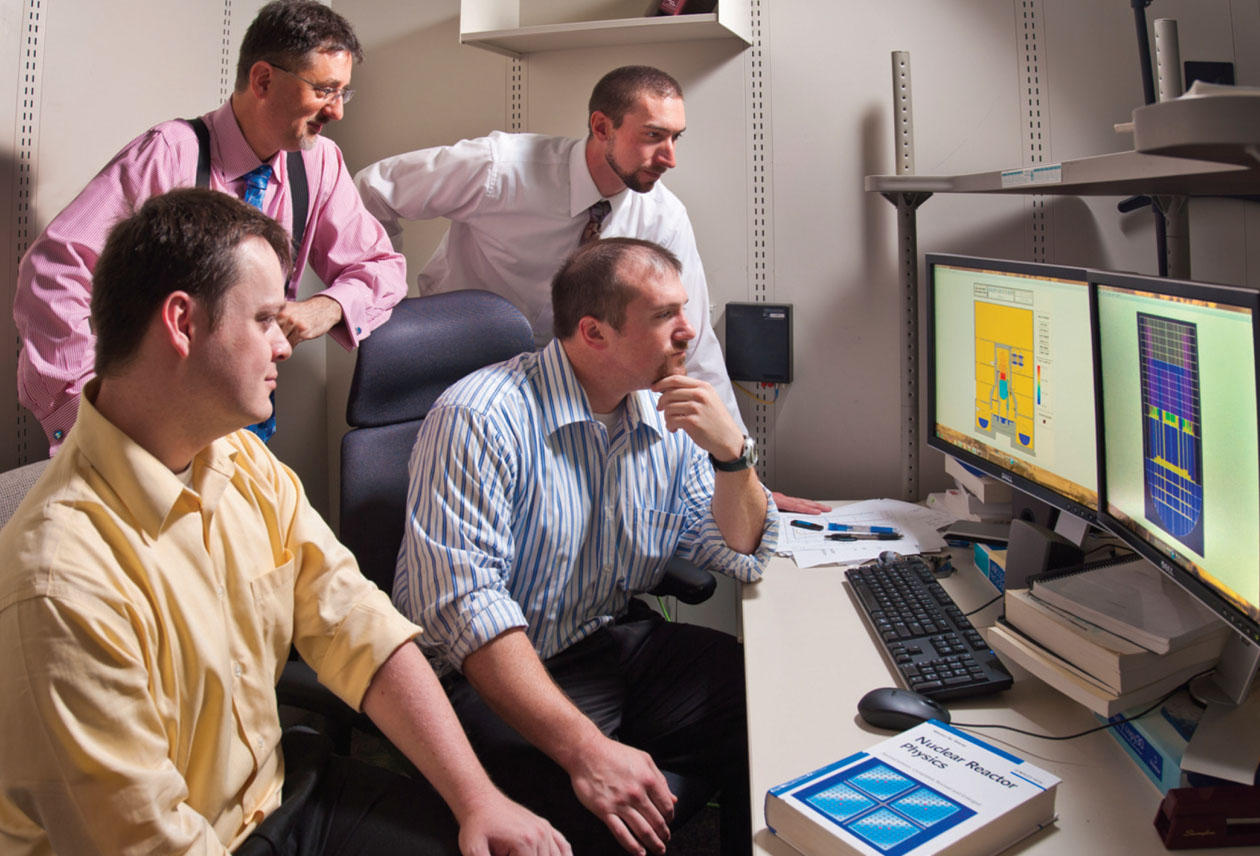
SANDIAN RESEARCHERS Don Kalinich, left rear, Andrew Goldmann, right rear, Jesse Phillips, left front, and Jeffrey Cardoni have used the Sandia-developed MELCOR code to analyze the 2011 Fukushima Daiichi reactor accident. (Photo by Randy Montoya)
Following the earthquake and devastating tsunami last year that damaged the nuclear power complex at Fukushima, Japan, Sandia experts were asked to apply the Labs’ 30-plus years of experience in modeling severe accidents to help reconstruct what happened there.
Sandia analysts say they hope the recently released “Fukushima Daiichi Accident Study” will assist researchers, operators, and regulators in understanding the accident and guide future efforts to improve reactor safety and responses to severe accidents. The work will also be used to validate the MELCOR code (a system-level severe accident analysis code developed by Sandia to help the NRC inform its decision-making process) and the Fukushima models, and suggest potential future data needs for improvements.
The project is a partnership among Sandia, Idaho, and Oak Ridge national laboratories. DOE and the Nuclear Regulatory Commission sponsored the report and have planned follow-up severe accident analyses.
Sandia began its studies of responses to severe nuclear accidents shortly after the Three Mile Island incident in 1979 that radically altered the future of nuclear power in the United States.
To model the Fukushima accidents, Sandia and Oak Ridge staff used the MELCOR code, which models an entire nuclear power plant, from the nuclear fuel rods to the reactor plumbing, the containment building out to the environment, and includes effects of safety systems and operator actions. Based on the state of a power plant just prior to an accident or other event, MELCOR calculates a simulation of the accident’s progression.
The Japanese government publicly released information about the design of the reactors and operator actions, which Sandia analysts used to develop input for the MELCOR code for each of the accident scenarios. This became the basis for the Fukushima Daiichi Information Portal, which Idaho National Laboratory developed for the US laboratory team and as an archive for use by future researchers. Existing MELCOR models for similar US reactors were used as templates to develop Fukushima-specific models of the Unit 1, 2, and 3 reactors and spent fuel pool 4.
Randy Gauntt, manager of Severe Accident Analysis Dept. 6232, which develops and implements the MELCOR code, says MELCOR allows researchers to analyze and understand what happens during a severe nuclear plant accident. Such studies support the development of advanced accident management and mitigation strategies, and improvements to reactor designs.
“On the whole, the MELCOR simulations have been found to replicate the observed events,” Randy says. “And the Fukushima events are exactly why we model low-likelihood accident sequences: to help understand the progression of serious accidents and, we hope, aid in preventing them from happening.”
Randy thanked the Japanese government for the opportunity to support the global response to the accident, and for Japan’s proactive role in sharing data about the accidents. He says Japan’s cooperation will advance the international nuclear industry’s understanding of what happened and expand its knowledge as the industry moves forward. Randy and his colleagues expressed their deepest sympathies for the Japanese people in this time of great national tragedy, and he says he hopes the modeling and analyses will support recovery activities in Japan.
Sandia serves as NRC’s principal contractor for severe reactor accident research and has provided regulatory research support for more than 30 years. Sandia’s MELCOR code is used by regulators in more than 27 countries, including the United States and Japan, for computational analysis of severe reactor accident progression and modeling of off-site consequences. Research analysts will continue to work on the Fukushima accident using their MELCOR models so they can continue learning more about what happened.
What happened at Fukushima
Note: The following information is adapted from the introduction to the recently released Fukushima Daiichi Accident Study.
Japan suffered an immense tragedy as a result of the 2011 Tohuku earthquake and resulting tsunami that caused widespread damage to the infrastructure of the country and more than 20,000 deaths, most from the tsunami.
The earthquake resulted in a scram (an emergency reactor shutdown) and a regional loss of electrical power, requiring the Fukushima Daiichi power plants (Units 1, 2, and 3) to start emergency on-site diesel powered generators to maintain cooling at the plants. Unit 4 was defueled at the time for maintenance, and Units 5 and 6 were in a state of cold shutdown for maintenance.
The tsunamis produced by the earthquake flooded buildings, resulting in the loss of emergency diesel-powered AC generators and producing conditions known as Station Blackout (SBO). DC power was also lost at Units 1 and 2. Units 1, 2, and 3 were effectively isolated from the ultimate heat sink (the ocean), and the emergency cooling systems eventually failed; each of the three units subsequently suffered core damage of varying degrees as a result of loss of water level in the reactor cores.
With no way to reject the decay heat from the reactors, the suppression pools quickly became thermally saturated. This produced pressures in the containment vessels that eventually exceeded their design pressures. Containment venting was attempted. However, due to difficulties in accessing and operating vent valves, venting was either unsuccessful or delayed.
Ultimately, the containment systems leaked, failed, or were intentionally vented, resulting in the release of radioactivity to the reactor buildings and the environment. Combustible gasses produced from the core damage and molten core–concrete interaction accumulated in the Unit 1 and Unit 3 reactor buildings, causing explosions and destruction of portions of the buildings.
Collectively, the accidents likely reflect varying degrees of core/reactor damage and are therefore an invaluable source of information that can validate/confirm the current understanding of severe reactor accidents and provide new insights.